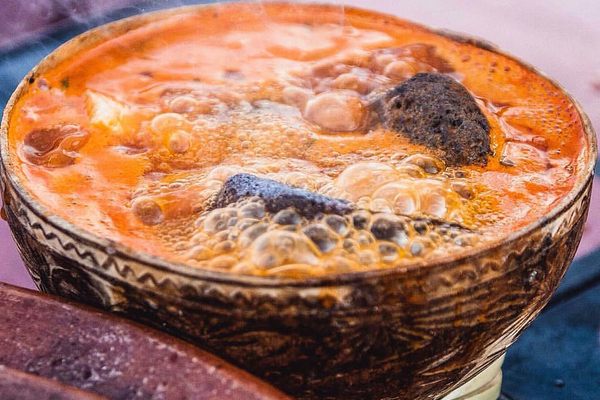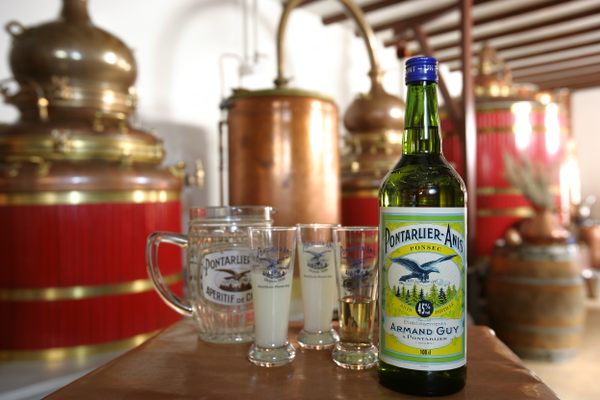Chocolate, which comes from the cacao tree, or Theobroma Cacao, has a lesser-known relative, Theobroma Bicolor, also known as pataxte or jaguar tree. Although rarely seen outside its native South and Central America, pataxte is an essential ingredient in a ceremonial Oaxacan drink called chocolate-atole.
Throughout the year, Oaxacans harvest pataxte seeds and bury them underground to ferment for one or two years for preservation. After they are dug up, washed, and sun dried on woven palm bedrolls, the beans turn white, delicate, and chalk-like. For this reason, pataxte is also known as cacao blanco, or white cacao, although the raw cacao is green with a light-brown pulp.
“Pataxte is not easy to find and, because of the process it goes through, it is expensive,” says James Beard Award-winning chef Iliana de la Vega, who comes from an Oaxacan family. “Traditionally, they are only used for these types of foamy drinks, ” she adds, referring to chocolate-atole. Pataxte has less caffeine than chocolate, but its high fat content, in combination with the fermentation process, creates lots of long-lasting foam.
De la Vega describes chocolate-atole as two drinks in one. “You have the warm atole on the bottom and the cool foam on top.”
Atole is a rich, thick, caloric-dense beverage made with corn masa (a dough of ground corn) and water. It can be flavored with ingredients such as pecans, blackberries, or regular chocolate and is found in markets and restaurants across Mexico. An atole flavored with regular chocolate is known as atole de chocolate or, in Oaxaca, as champurrado, and is not to be confused with chocolate-atole. In a chocolate-atole, the atole portion on the bottom is unflavored—what’s known as an atole blanco (white). Both cacaos are used in the ceremonial drink, but only to make the foam.
For chocolate-atole’s foam, the fermented pataxte is ground into a powder and mixed with ground cinnamon, toasted and ground corn or wheat, and regular ground cacao. Water is added to the mix, which is then whisked energetically with a wooden tool called a molinillo to create the foam. Chocolate-atole is always served alongside an alcahuete: a flat wooden stick that resembles a bookmark. Often carved into animal shapes at the top and painted brightly, they serve as the perfect tool to pick up but not deflate the foam, which can be enjoyed on its own or mixed into the atole.
“The drink is surprising because it doesn’t taste like chocolate,” says de la Vega, “The flavor is delicate, it’s not sweet, it has notes of nuts like almonds, and it feels thick and buttery.”
Since pre-Hispanic times, cacao has been culturally and culinarily important. Both cacao trees (Theobroma Cacao and Theobroma Bicolor) are mentioned in the foundational, sacred book of Mayan people, the Popol Vuh, and the foamy beverages made with their beans were reserved for religious events or ceremonies. The foam is associated with fertility, and as early as the 1500s, an image of a woman pouring hot chocolate to create a foam can be found in the Aztec Codex Tudela.
In Oaxaca’s central valleys, chocolate-atole remains a ceremonial drink for events such as weddings, a mayordomía (when a local mayor is named), or to celebrate a patron saint. It’s also a beloved treat, purchased by parents for children at Sunday markets.
If you visit, any market stand can take your order for chocolate-atole and, if needed, get someone from another stand to come over and sell it to you. But the markets listed below make particularly excellent versions themselves.
Where to Try It
-
For a true local market experience, visit this stand in Mercado de la Merced, where the foam overflows the serving bowl and you can enjoy your chocolate-atole with a large empanada filled with zucchini blossoms.
-
At the organic market La Cosecha, this stand offers excellent chocolate-atole where, in the manner of a food court, you can find and sample a variety of traditional foods and create a lovely spread.
Written By
 Isabel Torrealba
Isabel Torrealba















